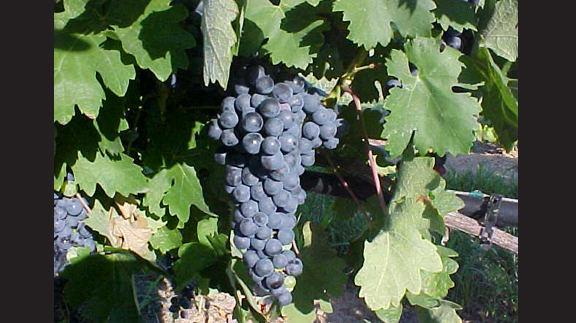Farm & Ranch
New publication explains ‘grape expectations’ for Texas vineyard owners

By: Kathleen Phillips
Writer: Kathleen Phillips, 979-845-2872, [email protected]
Contact: Dr. Jim Kamas, 830-990-4046, [email protected]
FREDERICKSBURG — Before planting grapes in Texas, every potential grower needs to answer one essential question, according to Jim Kamas: “Why do you want to plant a vineyard?”
Kamas, Texas A&M AgriLife Extension Service fruit specialist in Fredericksburg, begins with that question in his new book, “Growing Grapes in Texas: From the Commercial Vineyard to the Backyard Vine.”
This manual on grape growing in Texas was published by the Texas A&M University Press and is available at http://bit.ly/texasgrapebook for $25.
“After encountering hundreds of people interested in planting a vineyard over the past 35 years, the list of questions and misconceptions seemed to repeat themselves,” Kamas said. “So, I decided it was worth my time to sit down and respond to the multitude of choices and decisions every prospective grape grower faces. Most people do not comprehend the extent to which grape growing is a risky business, and while it is not ‘rocket science,’ it is indeed science.”
Kamas describes the different grape growing regions in Texas, while providing information for both a commercial venture and an at-home plot to help growers achieve the highest yields.
The 264-page book includes more than 160 color photos as Kamas discusses site choice and design, rootstock and fruiting varieties, pruning and training strategies, canopy and floor management, disease and pest control, water needs and nutrition requirements for grapes.
For those interested in commercial aspects of grape production, Kamas also provides information about vineyard-winery relations.
“The book seeks to relay to the reader not just instruction on how to establish a vineyard but to help the reader gain understanding of the scientific reasons behind why decisions are made,” Kamas said.
Grape and wine lovers from all parts of the country will find this book a valuable resource, according to the publisher.
-30-
Farm & Ranch
Managing Show Cattle Through The Winter

By Heather Welper
Husband and wife duo, Heather and Calvin Welper, are the Co-Owners and Operators or Two C Livestock, located in Valley View, Texas.
The pair’s operation has a show cattle focus where they raise and sell purebred heifers of all breeds and club calf Hereford steers.
When it comes to show cattle, the Welpers know a thing or two including how to prepare for the cold winter months and the Texas major show season run.
To read more, pick up a copy of the November edition of North Texas Farm & Ranch magazine, available digitally and in print. To subscribe by mail, call 940-872-5922.

Farm & Ranch
Double M Ranch & Rescue

By Hannah Claxton, Editor
As the sun rises each day, so do the dozens of mouths that Meghan McGovern is responsible for getting fed. Rather than the sounds of a rooster crowing, McGovern hears the bellows and bleats of a variety of exotic deer, the chortle of kangaroos, the grunts of water buffaloes, and the chirps of a lemur.
Nestled against the banks of the Red River, the Double M Ranch and Rescue, with its high game fences and deer sprinkling the landscape,s its in stark contrast to the surrounding ranches.
“Having deer is kind of like eating potato chips- you can never actually have just one,” said McGovern with a laugh.
McGovern has several herds to take care of- fallow deer, axis deer, water buffalo, goats, and bison. In smaller numbers, there’s also a few kangaroos, a lemur, a potbelly pig, a pair of zebras, a watusi, and a few horses.
To read more, pick up a copy of the November edition of North Texas Farm & Ranch magazine, available digitally and in print. To subscribe by mail, call 940-872-5922.

Farm & Ranch
Acorn Toxicity

By Barry Whitworth, DVM, MPH
With the prolonged drought, most pastures in Oklahoma end up in poor condition. With the lack of available forage, animals may go in search of alternative foods.
If oak trees are in the pastures, acorns may be a favorite meal for some livestock in the fall. This may result in oak poisoning.
Oak leaves, twigs, buds, and acorns may be toxic to some animals when consumed.
To read more, pick up a copy of the November edition of North Texas Farm & Ranch magazine, available digitally and in print. To subscribe by mail, call 940-872-5922.

-

 Country Lifestyles2 years ago
Country Lifestyles2 years agoScott & Stacey Schumacher: A Growth Mindset
-

 Country Lifestyles8 years ago
Country Lifestyles8 years agoStyle Your Profile – What your style cowboy hat says about you and new trends in 2017
-

 HOME8 years ago
HOME8 years agoGrazing North Texas – Wilman Lovegrass
-

 Outdoor10 years ago
Outdoor10 years agoButtercup or Primrose?
-

 Equine1 year ago
Equine1 year agoThe Will to Win
-

 Country Lifestyles5 years ago
Country Lifestyles5 years agoAmber Crawford, Breakaway Roper
-

 Country Lifestyles9 years ago
Country Lifestyles9 years agoJune 2016 Profile – The man behind the mic: Bob Tallman
-

 Country Lifestyles8 years ago
Country Lifestyles8 years agoDecember 2016 Profile, Rusty Riddle – The Riddle Way




